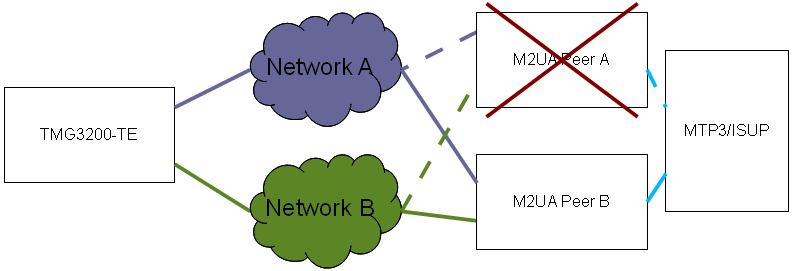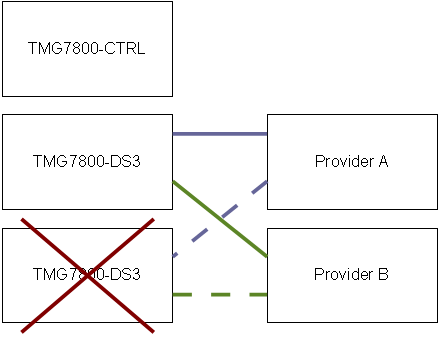Redundancy & High Availability:Software:Signaling Protocols
(add cas, isdn, sip text and example) |
(add ss7 information for TMG7800) |
||
| Line 6: | Line 6: | ||
TelcoBridges recommends to use 2 timeslots as MTP2 links on different line interface. This will protect against [[T1,_E1,_and_J1_interfaces|E1/T1]] or [[DS3_interfaces|DS3]] failure. Also, the [[TMG3200-DS3]] and [[TMG3200-STM1]] have 2 signaling ports that can be configure as MTP2 links. | TelcoBridges recommends to use 2 timeslots as MTP2 links on different line interface. This will protect against [[T1,_E1,_and_J1_interfaces|E1/T1]] or [[DS3_interfaces|DS3]] failure. Also, the [[TMG3200-DS3]] and [[TMG3200-STM1]] have 2 signaling ports that can be configure as MTP2 links. | ||
| − | |||
The following example shows the redundancy of [[MTP2_Layer|MTP2]] links. | The following example shows the redundancy of [[MTP2_Layer|MTP2]] links. | ||
| Line 38: | Line 37: | ||
=== CAS/ISDN/SIP === | === CAS/ISDN/SIP === | ||
| − | With [[TMG7800]] system composed of multiple telecom units, it is recommended to spread the TDM connections between the providers between the telecom units. | + | With [[TMG7800]] system composed of multiple telecom units, it is recommended to spread the TDM connections between the providers between the telecom units. |
| − | The next example shows 2 TMG7800 Telecom units connected to 2 providers with | + | The next example shows 2 TMG7800 Telecom units connected to 2 providers with ISDN stacks load shared between them (CAS and SIP can be configured in a similar fashion): |
[[Image:Ha_TMG7800_TDM_Load_Share.png|TMG7800 TDM Interfaces Load Sharing]] | [[Image:Ha_TMG7800_TDM_Load_Share.png|TMG7800 TDM Interfaces Load Sharing]] | ||
| Line 49: | Line 48: | ||
| − | === SS7 | + | === SS7 === |
| + | |||
| + | TelcoBridges [[SS7]] stack has a multitude of redundancy mechanism that can fortify a [[TMG7800]] system against failure. | ||
| + | *[[MTP2]] Link Redundancy | ||
| + | *[[MTP3]] layer is shared between multiple telecom units | ||
| + | *[[ISUP]] layer Redundancy | ||
| + | |||
| + | |||
| + | === SIGTRAN === | ||
| + | |||
[[Category:Tmedia_High_Availability|Signaling Protocols]] | [[Category:Tmedia_High_Availability|Signaling Protocols]] | ||
Revision as of 15:10, 10 February 2011
The most recent signaling protocols have inherent redundancy and high availability features. For the other signaling protocols, there are still way to improve service availability.
Contents |
TMG800 / TMG3200 Series
SS7
TelcoBridges recommends to use 2 timeslots as MTP2 links on different line interface. This will protect against E1/T1 or DS3 failure. Also, the TMG3200-DS3 and TMG3200-STM1 have 2 signaling ports that can be configure as MTP2 links.
The following example shows the redundancy of MTP2 links.
The SS7 network is still available if 1 link goes down.
SIGTRAN
SIGTRAN supports multiple destination addresses and peers to create redundancy.
The following example shows how M2UA can take advantage of the Tmedia dual VoIP interfaces to create a redundant system (Note: M2PA and M3UA have similar features).
The M2UA system is still operational even if there is a network failure.
The M2UA system is still operational even if a M2UA peer goes down.
TMG7800
CAS/ISDN/SIP
With TMG7800 system composed of multiple telecom units, it is recommended to spread the TDM connections between the providers between the telecom units.
The next example shows 2 TMG7800 Telecom units connected to 2 providers with ISDN stacks load shared between them (CAS and SIP can be configured in a similar fashion):
Even if a telecom units fails, all the providers will be accessible through other unit:
SS7
TelcoBridges SS7 stack has a multitude of redundancy mechanism that can fortify a TMG7800 system against failure.






